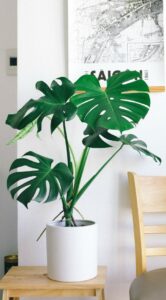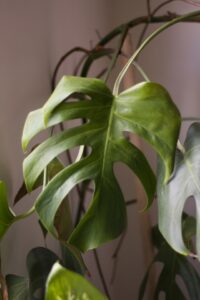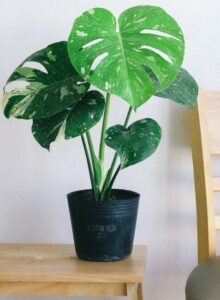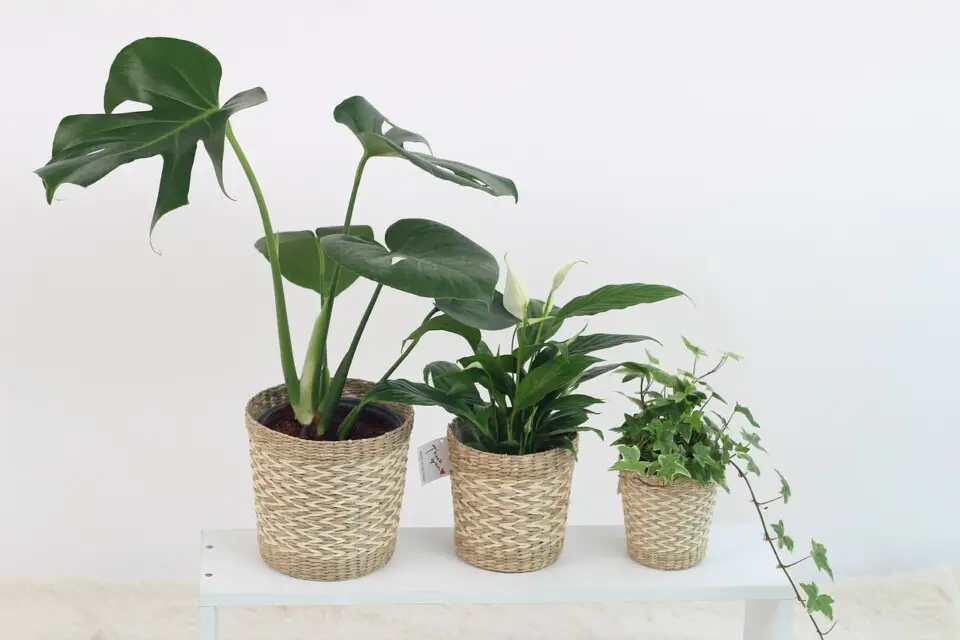Some links in the post are affiliate links and I get a commission from purchases made through some links found in the post.
Monstera plants are known for their unique looks, but it all comes with a price.
It can be quite tricky to maintain this plant, especially in terms of light requirements, but with proper understanding, caring for your monstera doesn’t have to be so difficult.
The ideal amount of light for your monstera plant is bright indirect light as it encourages it to grow properly.
You can also choose to grow this plant using artificial light, however, you need to gain knowledge on some key details before deciding the type of lighting for your monstera.
Going further into this article, you will learn more about monstera lighting requirements and this knowledge will help you take better care of your plant.
What Type of Light Does my Monstera Need?
Your monstera plant needs indirect light or artificial light. These lights are less intense and suitable for the somewhat fragile nature of monstera plants.
Indirect Light
 Monstera plants are native to tropical rainforests making direct sunlight the least suitable option for them.
Monstera plants are native to tropical rainforests making direct sunlight the least suitable option for them.
They are situated at the lowest canopy that receives indirect sunlight from other plants reducing the intensity of the direct sunlight.
The best way to supply this plant with indirect light is to position it a few feet away from your window and do not allow your monstera to cast a shadow, it indicates that there is too much sunlight.
This amount of sunlight will facilitate the growth of this indoor plant, you also have to ensure that the environment surrounding your monstera does not have a low light intensity as this plant does not thrive well under low light.
Artificial Light
Artificial lighting becomes an option if your monstera plant is in an area with little natural light.
Using artificial lights will require you to follow strict guidelines and use only specific types of light that will favor the growth of your plant, you will also need to consider a lot of factors before choosing this method as a source of light for your monstera.
We will cover artificial lighting in detail later in this article so that you can get a clearer picture.
How Much Light Does a Monstera Need?
Now that you are informed on the type of light your monstera needs, you must know the amount of light it needs. This plant requires medium light and they are various ways to ensure that it gets this required amount of light.
Using a Light Meter
A light meter is a device used to accurately measure the amount of light in an area. the University of Florida Gardening Solutions has provided the correct reading scale of a light meter and it is measured in foot candles.
Obtaining a reading between 25-100 foot candles signifies a low light intensity, a reading that ranges from 100-500 foot candles indicates a medium-light intensity. A light intensity above 500-foot candles can be classified as high intensity.
Using this light meter, you can ensure that your monstera plant receives the medium light necessary for growth.
Shadow Assessment
A shadow assessment is another way to determine the amount of sunlight your plant is receiving.
A good rule of thumb is to make certain that your monstera does not cast a shadow with the presence of light, you can carry out this test using the procedures below.
- Hold out your hand 12 inches away from your monstera, this should be done in the space between your plant and the source of light
- Observe the shadow of your hand. If the shadow is dull and blurry, then your monstera is receiving the right amount of medium light. If the shadow produced is clearly outlined, then your monstera is receiving way too much light
- If the position does not provide the ideal amount of light required for proper growth, then change the position
What Happens if your Monstera gets Too Little Light?
When your monstera plant gets insufficient light, it starts to exhibit some unusual behaviors that may get worse if not fixed.
You may start to notice that your monstera leaves won’t split as adequate light is necessary for this process.
You may also notice some discoloration on the leaves and they may come in form of brown spots or yellowing of some parts of the leaves.
Stunted growth and wet soil that does not dry easily are also indications that your monstera plant needs more light.
Monstera plants need about 5-12 hours of light, 5-6 hours of light is considered good enough for this plant, but 8-12 hours of light will help it grow properly.
What Happens if your Monstera gets Too Much Light?
 When your monstera plant receives too much sunlight it becomes sunburnt.
When your monstera plant receives too much sunlight it becomes sunburnt.
This burn can be caused by exposure to high light intensity or dehydration of the plant, some noticeable signs of sunburn in monstera include burn spots on some part of the leaves, discoloration of the foliage, the soil or potting mix becomes completely dry, and your plant will start to droop and wilt.
This problem can be fixed by reducing the light intensity or completely removing your plant from that position. You will need to cut off the sunburnt leaves and hydrate your plant to help it recover.
Where to Place your Monstera to get the Best Light
Monstera plant thrives as an indoor plant, and with this being said, it needs an indirect medium light that is supplied to a room with windows.
It is best to position your monstera close to windows, and even after this placement, you should test the light intensity of the selected area.
You can position our monstera plant on your northern window, eastern window, or southern window.
Northern Window
The northern window is suitable for plants that grow with little light as it supplies that amount of light, in some cases, your monstera will need to be closer to the window when receiving light from the northern window.
Eastern Window
Eastern windows are known for receiving the bright morning light which can be very useful to your monstera. This morning light does not cause sunburns or dehydration making it a perfect way for this plant to start a day.
Southern Window
A southern window receives an intense daylight sun. Your monstera plant should be placed a few inches away from a southern window and the amount of light in the area should be determined to know if it is capable of causing sunburns.
Will Monstera Grow in Shade?
Monstera is a shade-loving plant that doesn’t need direct sunlight. If the area your plant is positioned in has access to direct sunlight, then you can organize a shade to reduce the light intensity.
However, a deep shade may not aid the serious growth of your monstera plant.
A shade is also a great option if you are considering planting your monstera outdoors. Even outdoors, a deep shade may inhibit the growth of your monstera and may even delay the leaves cutting.
Does Monstera do Well in Direct Sunlight?
Direct sunlight from the morning sun is not at all harmful to a monstera plant as it is not capable of causing sunburns.
However, the daylight sun can be very intense, and direct exposure of your monstera to this amount of light can cause damage.
You can always keep your monstera plant away from sunlight by changing its position or adding some shade. We have listed some of the signs of sunburn in monstera plant and fortunately, this problem can be fixed if noticed on time.
Can Monstera Grow in Artificial Light?
 If your monstera plant is in an environment with low sunlight, then you need not worry as you can still grow it using artificial light.
If your monstera plant is in an environment with low sunlight, then you need not worry as you can still grow it using artificial light.
However, at a different stage of growth of a monstera plant, different lights will need to be used.
For leaf growth, you should use a blue wavelength light and a red wavelength light ideal for flowering and fruiting. You don’t need green wavelength light as they don’t have much impact on your plant because they are reflected.
Different types of artificial lights can be considered for growing monstera plants, these lights have different individual functions so an understanding of them will help you decide the type you need.
Fluorescent Lights
Fluorescent lights are the most common type of bulb light that can be screwed into place in any home.
These lights are presented in compact fluorescent lamps (CFLs) or tubes, an ideal choice in this category should be the full spectrum bulbs or a combination of cool and warm bulbs.
If you are still indecisive about the type of fluorescent light to choose, you can opt for the cool white as it contains various wavelengths capable of growing your monstera plant just fine.
The correct placement of this light is one foot away from your monstera.
Incandescent Lights
Incandescent light is a bulb light made of filament. The filament is heated until it glows to produce light.
With this being said, incandescent lights produce a lot of heat and should be used at a reasonable distance for lighting your monstera plant.
The heat of this light is caused because it emits a red wavelength which is important for flowering.
You can combine incandescent light and fluorescent lights for better growth of your monstera and this is done in a combined ratio of 1/3 incandescent light and 2/3 fluorescent light.
LED Lights
LED lights are known for their radiant glow and their eco-friendly feature.
This type of light utilizes less energy and is mostly available in blue wavelengths, they generate adequate lighting for your plant and the red wavelength is also available to be utilized.
The best option when it comes to choosing LED lights is the horticultural grow light as they produce light that can be used by shade-loving plants like monstera for photosynthesis.
The only problem you may have with this lighting system is that it is expensive and less diffusive than other types of lights.
Metal Halide Lights
These are also known as halogen lights and they produce light very close to the one produced by the sun.
They have a long service life as they are capable of working for over 20,000 hours, however, they produce a lot of heat and will need to be distanced from your monstera plant.
How to Grow a Monstera using Artificial Lights
Without proper guidance, setting up an artificial lighting system for your plant can be frustrating, and even worse, an incorrect placement may lead to your monstera developing burns.
Follow the steps below to grow a monstera plant using artificial lights.
- It is best to use a standing light that can be adjusted for this setup
- For the safety of your plant, use two fluorescent bulbs and one incandescent bulb and the light should be directed towards your plant
- To prevent any damage that can be caused by heat towards your plant, place the fluorescent lights closer to the plant than the incandescent light. Fluorescent lights should be 12 inches from your plant while incandescent lights should be 24 inches from your plant.
- This should be done daily for 16 hours. But if you have moments of short sunlight in your indoor space, then you can use this lighting for 3 to 4 hours.
This method is perfect for a simple indoor monstera plant, a larger space will utilize LED lights.
You should be aware that several factors will contribute to your purchase of artificial lights.
If you have more than one monstera plant, then you will need to purchase more bulbs, in a situation where you are busy all day, grow lights with timers will be helpful to regulate the amount of light your monstera plant receives.
Final Thoughts
 Monstera is a shade-loving plant that requires a medium indirect light for proper growth.
Monstera is a shade-loving plant that requires a medium indirect light for proper growth.
Correct positioning and shading are also key concepts that can be applied to giving your plant adequate light.
We hope that this article has provided all the information you need on monstera light requirements.


